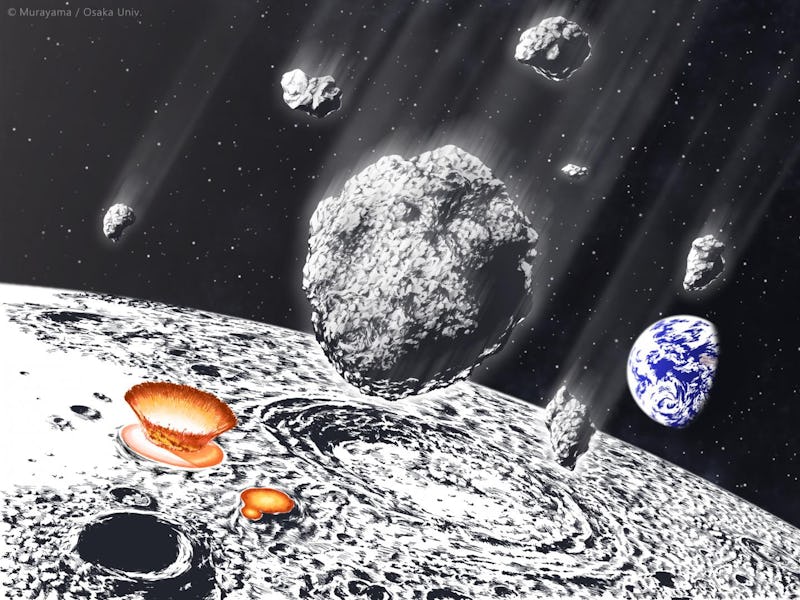A new study of the moon has revealed how 70 percent of life on Earth died

Hundreds of millions years ago, the Solar System was a violent place: Massive rocks were flying at our planet and its only natural satellite; the Moon. But as Earth developed, organic material covered up its old bumps and bruises. Meanwhile, while the lunar surface -- and all its craters -- was left exposed.
In order to learn the ancient history of our planet, we have to look to the Moon.
So scientists did just that, examining 59 craters on the lunar surface. From their research, published in a new study, they learned that a giant asteroid collided with the Earth and Moon around 800 million years ago, contributing to mass extinction on Earth.
The study, published in the journal Nature on Tuesday, also suggests that this asteroid was the main source of phosphorus on Earth, which larger affected the planet's environment.
Scientists examined lunar craters such as this one to retrace the violent impact that took place around 800 million years ago.
The team of researchers behind the study used data from the Japanese lunar orbiter KAGUYA.
The spacecraft was launched in September 2007, as the second mission by the Japanese Space Agency (JAXA) to explore the Moon from orbit. KAGUYA, or Moon Princess, spent almost two years in lunar orbit, collecting data on the origins and geological evolution of the Moon.
After examining the 59 craters of the Moon that measured approximately more than 20 kilometers across, the researchers found that eight of them had formed at the same time — 800 million years ago. Based on that evidence, the team suggests that the craters must have formed as a result of a meteorite shower.
The study also found that these craters date back to the same time of an asteroid known as Eulalia, which was once believed to be a small planet, approximately 100 kilometers in diameter, orbiting the Sun every 1,432 days.
However, Eulalia suddenly broke apart into smaller fragments around the same time of the impact craters on the Moon. Scientists believe that some of these fragments struck Earth and other planets in the Solar System, while others stayed in the asteroid belt and became known as part of the Eulalia family or became near-Earth asteroids that orbit around the Solar System.
Based on the new study, the Eulalia asteroid resulted in a meteorite shower containing between 40 and 50 quadrillion kilograms of meteoroids that impacted both the Earth and the Moon, at a staggering rate that is 30-60 times more than the impact that created the Chicxulub crater. Chicxulub is an impact crater that was found beneath the Yucatán Peninsula in Mexico, and believed to have formed from the collision of a massive asteroid measuring at 80 kilometers in diameter which lead to the mass extinction of the dinosaurs.
However, the new study also suggests that the meteorite shower caused by Eulalia also contributed to large amounts of phosphorus making its way to Earth, which the scientists believe largely affected the formation of new forms of life on our planet.
The Cretaceous-Paleogene extinction event may have resulted in the death of more than 70 percent of plants and animals on Earth, including the dinosaurs. But following the death of the dinosaurs, large mammals prospered and procreated for the first time in Earth’s history — ultimately leading to life as we know it today.
The Cenozoic Era, which translates to the Greek phrase meaning “new life,” began around 65 million years ago.
Abstract: Meteoroid bombardment of the Earth-Moon system must have caused catastrophic damage to the terrestrial ecosphere. However, ancient meteoroid impacts and their relations to environmental changes are not well understood because of erosion and/or resurfacing processes on Earth. Here, we investigate the formation ages of 59 lunar craters with fresh morphologies and diameters greater than approximately 20 km and first find that 8 of 59 craters were formed simultaneously. Considering the radiometric ages of ejecta from Copernicus crater and impact glass spherules from various Apollo landing sites, we conclude that sporadic meteoroid bombardment occurred across the whole Moon at approximately 800 Ma. Based on crater scaling laws and collision probabilities with the Earth and Moon, we suggest that at least (4–5) × 1016 kg of meteoroids, approximately 30–60 times more than the Chicxulub impact, must have plunged into the Earth-Moon system immediately before the Cryogenian, which was an era of great environmental changes.